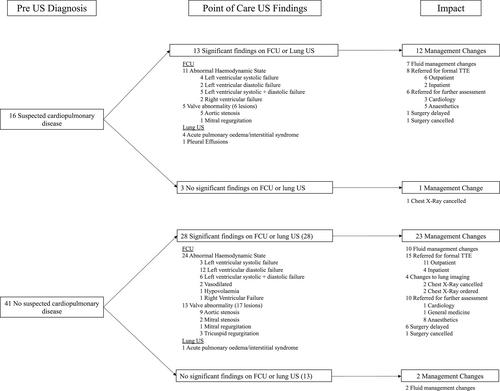Impact of focused cardiac and lung ultrasound screening performed by a junior doctor during admission to the surgical ward on patients before emergency non-cardiac surgery: A pilot prospective observational study
Abstract
Purpose
To assess whether pre-operative focused cardiac ultrasound and lung ultrasound screening performed by a junior doctor can change diagnosis and clinical management of patients aged ≥65 years undergoing emergency, non-cardiac surgery.
Method
This pilot prospective observational study included patients scheduled for emergency, non-cardiac surgery. The treating team completed a diagnosis and management plan before and after focused cardiac and lung ultrasound, which was performed by a junior doctor. Changes to diagnosis and management after ultrasound were recorded. Ultrasound images were assessed for image and diagnostic interpretation by an independent expert.
Results
There was a total of 57 patients at age 77 ± 8 years. Cardiopulmonary pathology was suspected after clinical assessment in 28% vs. 72% after ultrasound (including abnormal haemodynamic state in 61%, valvular lesions in 32%, acute pulmonary oedema/interstitial syndrome in 9% and bilateral pleural effusions in 2%). In 67% of patients, the perioperative management was changed. The changes were in fluid therapy in 30%, cardiology consultation in 7%, formal in- or out-patient, transthoracic echocardiography in 11% and 30% respectively.
Discussion
The impact of pre-operative focused cardiac and lung ultrasound on diagnosis and management of patients on the hospital ward before emergency non-cardiac surgery by a junior doctor was comparable to previous studies of anaesthetists experienced in focused ultrasound. However, the ability to recognise when image quality is insufficient for diagnosis is an important consideration for novice sonographers.
Conclusions
Focused cardiac and lung ultrasound examination by a junior doctor is feasible and may change preoperative diagnosis and management in patients of 65 years or older, admitted for emergency non-cardiac surgery.


 求助内容:
求助内容: 应助结果提醒方式:
应助结果提醒方式:


